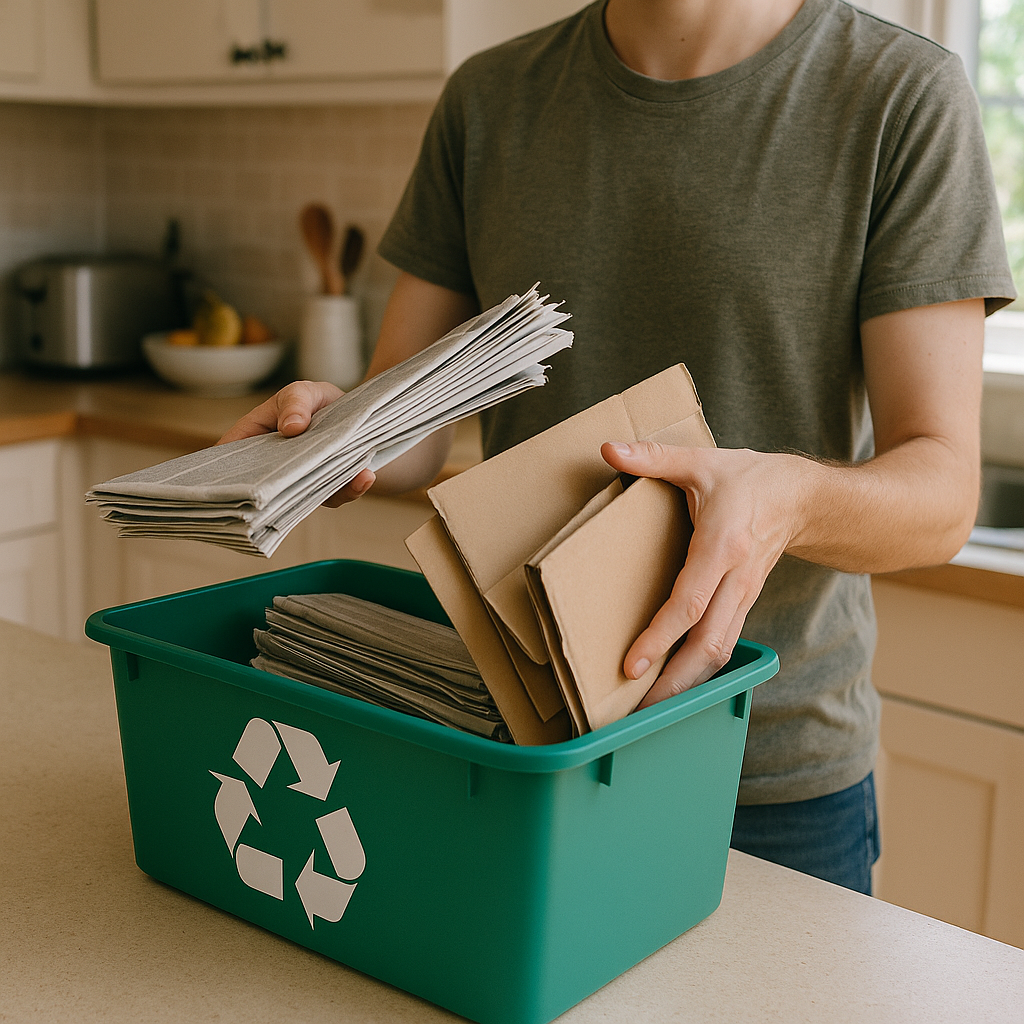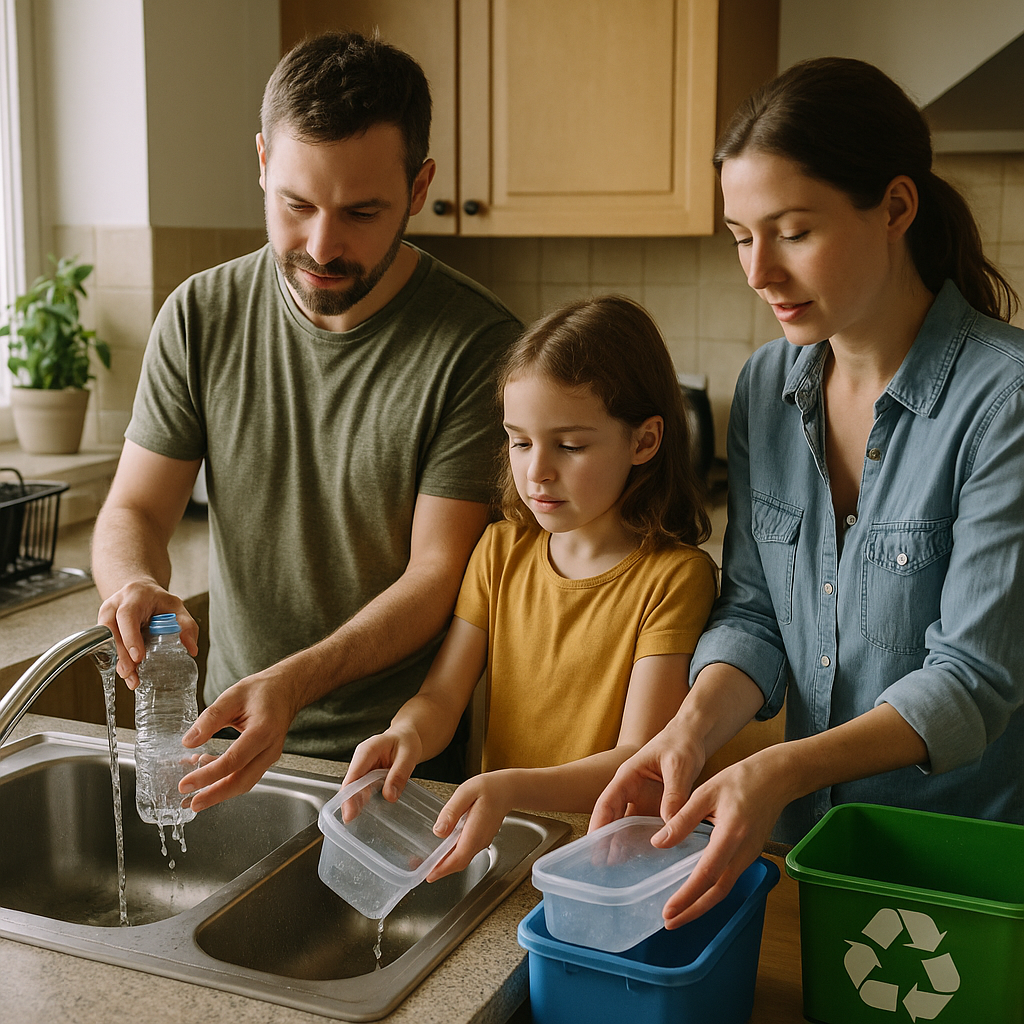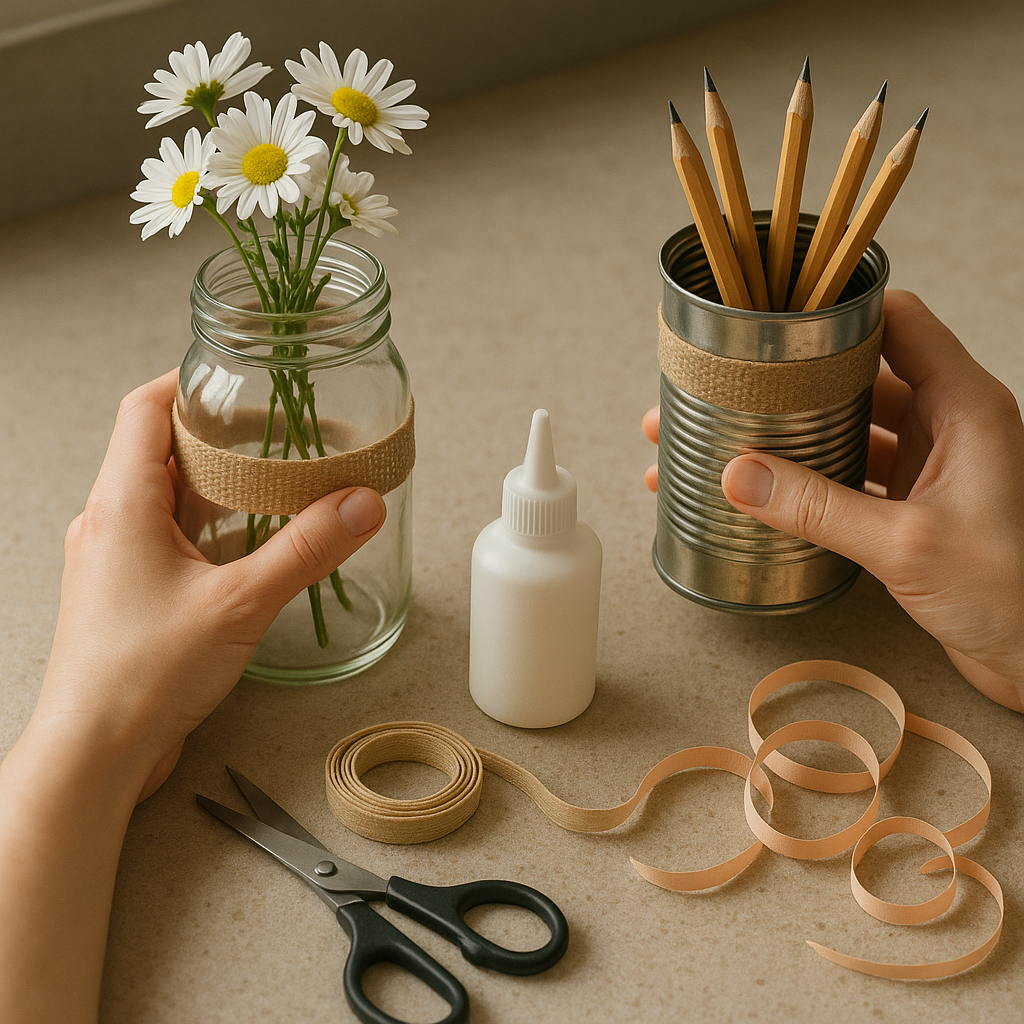5901 Botham Jean Blvd, Dallas, TX 75215
Discover the Common Recyclable and Reusable Household Items?
August 27, 2025Every day, we generate waste that could find new life through recycling or reusing. The average person creates nearly five pounds of garbage daily, amounting to over 1,600 pounds per year per person. By understanding which household items can be recycled or reused, we can significantly reduce this environmental burden.
Most homes contain numerous items that don’t need to end up in landfills. Paper products like newspapers, magazines, and cardboard boxes are widely accepted by recycling programs. Clean plastic bottles, aluminum cans, and glass containers are equally valuable in recycling streams. Even everyday items like egg cartons, glass jars, and takeout containers can be reused multiple times before disposal.
The key to effective recycling begins with recognizing which items in your home can be diverted from the trash. As municipal recycling programs become more accessible and efficient, transforming your household waste into valuable resources has never been easier.
How Can Paper and Cardboard Products Be Recycled or Reused?

Paper and cardboard account for about 23% of municipal solid waste, surpassing any other material. Americans recycle approximately 68% of the paper they use, making it one of the most successfully recycled materials. This high recycling rate conserves trees, water, and energy while decreasing landfill waste.
Recycling Paper Products
Most paper products are recyclable through municipal programs. Common recyclable paper items include:
- Newspapers and inserts
- Magazines and catalogs
- Office paper and envelopes (even those with plastic windows)
- Cardboard boxes (flattened to save space)
- Paperboard from cereal boxes, toothpaste boxes, and similar packaging
- Phone books and paperback books
- Junk mail and bills
Many are surprised to learn that pizza boxes can be recycled if they are free of food residue and excessive grease. When uncertain, recycle the clean portions and compost or discard the soiled parts.
Preparing Paper for Recycling
To ensure proper recycling:
- Remove non-paper materials such as plastic wrapping, metal fasteners, or excessive tape
- Keep paper dry and clean
- Flatten cardboard boxes to save space
- Check local guidelines for specific instructions
A common question is whether to remove staples and paper clips. Most modern recycling facilities have equipment to handle these small metal items, so removal is usually unnecessary.
Creative Ways to Reuse Paper and Cardboard
Before recycling, consider giving paper products a second life through reuse:
Cardboard Box Reuse Ideas
- Storage containers for seasonal items, toys, or garage supplies
- Drawer dividers and closet organizers
- Seedling starters for your garden
- Homemade cat scratching posts (accordion-folded cardboard)
- Moving supplies or shipping materials
- Children’s play structures or costume pieces
- Compost material (shredded and dampened)
Magazine and Paper Reuse Ideas
- Unique gift wrapping paper
- Decoupage art projects
- Homemade envelopes or paper beads for jewelry
- Wall art or collages
- Protective packing material (shredded)
- Fire starters for campfires (tightly rolled)
- Homemade recycled paper for crafts or cards
Did You Know? Paper can be recycled five to seven times before the fibers become too short to create new paper. Each recycling cycle shortens the fibers, eventually requiring a mix with virgin fibers to produce new products. This is why the paper recycling industry often refers to paper as having “seven generations” of use!
By properly recycling and creatively reusing paper products, we can significantly reduce waste, conserve natural resources, and decrease the environmental impact of paper production. For every ton of paper recycled, approximately 17 trees, 7,000 gallons of water, and 463 gallons of oil are saved.
What Are the Best Practices for Recycling and Reusing Plastics?

Not all plastics are created equal when it comes to recycling. Knowing which types are recyclable and how to prepare them properly can greatly improve waste management efforts. Understanding the resin identification codes—those small numbered triangles on plastic items—is crucial for effective plastic recycling.
Know Your Plastic Types
Plastics labeled with numbers 1 (PET) and 2 (HDPE) are the most commonly recyclable types in most recycling programs. These include water bottles, soda containers, milk jugs, and detergent bottles. They have well-established recycling markets and can be efficiently transformed into new products.
Number 5 (PP) plastics, such as yogurt containers and butter tubs, are increasingly accepted by many recycling programs. However, plastics labeled 3, 4, 6, and 7 often have limited recyclability and may be rejected by many facilities due to the lack of viable markets or processing challenges.
Preparation Is Key
Clean, empty, and dry—these three words should guide your plastic recycling efforts. Food residue can contaminate entire batches of recyclables, rendering them unusable. Rinse containers thoroughly, ensuring they’re completely empty before placing them in your recycling bin.
Remove caps from bottles unless your local program specifically accepts them. Some facilities can process attached caps, while others require them to be separated. Always check your local guidelines.
Avoid placing plastic items smaller than a credit card in recycling bins. These small pieces can jam sorting equipment and often end up as waste regardless of their plastic type.
Special Considerations for Plastic Bags and Films
Plastic bags and films require special handling. These items should never go in curbside recycling bins as they can tangle in sorting machinery, causing damage and delays. Instead, collect clean, dry bags and films for drop-off at designated collection points, typically found at grocery stores and retail locations.
Items suitable for store drop-off include grocery bags, bread bags, produce bags, newspaper sleeves, and clean food storage bags. Look for collection bins near store entrances specifically marked for plastic film recycling.
Creative Reuse Ideas
Before recycling, consider if plastic items can be reused, extending their life cycle and reducing the need for new plastics. Some practical reuse ideas include:
- Converting plastic bottles into planters for herbs or small plants
- Using sturdy containers for storage and organization
- Repurposing plastic coffee creamer containers as small item storage
- Creating bird feeders from plastic bottles
- Using plastic containers as travel-sized toiletry holders
For more durable plastics, like food storage containers, consider washing and reusing them multiple times before recycling. Many containers designed for single use can safely be reused several times, extending their useful life.
Reducing Plastic Consumption
The most effective way to tackle plastic waste is to reduce consumption from the start. Simple strategies include:
Carry reusable shopping bags, water bottles, and coffee cups. Choose products with minimal or plastic-free packaging when shopping. Opt for biodegradable or reusable alternatives to plastic cutlery, straws, and other single-use items.
When plastic use is unavoidable, select items made from more recyclable plastics (types 1, 2, and 5) whenever possible. Be mindful of products with combined materials, as they are typically not recyclable.
By understanding how to recycle different plastic types properly, preparing items correctly for recycling, and incorporating reuse into your routine, you can significantly reduce plastic waste and its environmental impact.
How Can Glass and Metal Items Be Recycled or Repurposed?

Glass bottles and jars can be recycled indefinitely without losing quality. This recyclability positions glass as one of the most sustainable packaging materials today. The recycling process consumes less energy compared to creating new glass from raw materials, significantly reducing carbon emissions.
Metal items, particularly aluminum and steel, are also invaluable in recycling. Aluminum cans can be recycled endlessly without quality degradation. Energy savings are substantial – recycling aluminum uses 95% less energy than producing new aluminum from bauxite ore. A recycled can might return to store shelves as a new container in just 60 days.
Recycling Methods
Most municipalities collect glass and metal through curbside recycling programs. Before recycling, remove caps, lids, and rinse containers to eliminate food residue. Labels can usually stay on glass jars as they are removed during processing.
Steel and tin cans, commonly used in food packaging, are separated from other recyclables using magnets at sorting facilities. In the United States, metals have a recycling rate of about 70%, making them one of the most frequently recycled materials.
Creative Repurposing Ideas
Beyond conventional recycling, glass and metal can be creatively repurposed. Glass bottles and jars make attractive vases, food storage containers, or decorative pieces. Clear glass containers can become terrariums for small plants, while colored glass bottles serve as stunning decorative elements.
Metal cans can be transformed into pencil holders, planters, or luminaries. With minimal cleaning and preparation, these everyday items can find new uses in your home or garden. Steel food cans, once cleaned and with edges smoothed, can become durable containers for workshop organization or garden tool storage.
DIY Project: Tinted Glass Vases
Transform ordinary glass bottles into decorative vases with this simple technique:
1. Clean the bottle thoroughly, removing labels and adhesive residue.
2. Mix school glue with a few drops of food coloring in your desired shade.
3. Pour the mixture into the bottle and swirl to coat the inside completely.
4. Turn the bottle upside down to drain excess mixture.
5. Allow to dry completely (approximately 24 hours).
6. The result is a beautiful, translucent colored vase perfect for displaying fresh or dried flowers.
Metal Upcycling: Luminaries
Create charming luminaries from tin cans with these steps:
1. Remove labels and wash cans thoroughly.
2. Fill with water and freeze overnight (this prevents denting during the next step).
3. Draw or trace a pattern on the outside.
4. Using a nail and hammer, punch holes following your pattern.
5. Once complete, let the ice melt and dry the can.
6. Place a tea light inside for a beautiful ambient light effect.
These luminaries are ideal for outdoor gatherings or adding warm light to indoor spaces.
Environmental Impact
Every glass bottle or metal can diverted from landfills makes a difference. Glass takes over 4,000 years to decompose naturally, while aluminum cans may take 80-200 years. By recycling or repurposing these materials, we conserve natural resources and reduce the energy needed for manufacturing new products.
Recycling one ton of aluminum saves about 14,000 kilowatt-hours of electricity, enough to power an average home for over a year. Steel recycling saves enough energy annually to power about 18 million homes for a year.
Beyond Home Recycling
Communities often have specialized recycling programs for unusual glass and metal items. Check with local recycling centers for programs that accept window glass, mirrors, or specialized metal items like propane tanks or electronics that contain valuable metals.
Some artists and craftspeople collect specific glass or metal items for creative projects. Consider donating unique bottles or interesting metal pieces to local creative reuse centers where they can find new purpose in art projects.
What Are Creative Ways to Reuse Common Household Items?

Transforming everyday household items into new creations reduces waste while saving money. Creative reuse grants disposable products a second life instead of sending them to landfills. Upcycling converts potential trash into functional items with minimal effort.
Kitchen Items That Deserve a Second Life
Glass jars from pasta sauce, pickles, and jams make versatile storage containers. Clean them thoroughly and use them to store bulk foods like rice, beans, and nuts purchased from zero-waste stores. They also serve as excellent containers for homemade beauty products such as body scrubs or bath salts.
Coffee grounds offer surprising versatility beyond your morning brew. Use them as natural fertilizer for acid-loving plants like roses and blueberries. You can also mix them with coconut oil to make an invigorating body scrub that helps reduce the appearance of cellulite while exfoliating skin.
Empty egg cartons work perfectly as seed starters for your garden. Fill each compartment with soil and plant seeds for herbs or vegetables. They naturally break down when planted directly in soil. Alternatively, cardboard egg cartons can organize small jewelry items like earrings and rings.
Textile Transformations
Old clothing and bedding need not end up in the trash. Cut worn-out t-shirts, towels, and sheets into squares to create reusable cleaning rags that replace paper towels. The soft fabric of old flannel shirts makes excellent dust cloths, while terry cloth towels work well for kitchen spills.
For pet owners, transforming old clothing into pet toys saves money and reduces waste. Braid strips of old t-shirts to create tug toys for dogs. Stuff old socks with more fabric scraps and tie the end to make a simple cat toy that provides hours of entertainment.
Creative Container Conversions
Plastic bottles can be transformed into practical household items. Cut the bottom portion of a large plastic bottle to create a scoop for pet food or garden soil. Cut larger bottles in half to use the bottom section as small planters for herbs or succulents.
Tin cans from vegetables or soup make charming herb garden containers. Clean them thoroughly, punch holes in the bottom for drainage, and decorate the outside with paint or fabric. Line them up on a windowsill for a functional kitchen herb garden that adds fresh flavor to meals.
Paper Products Reimagined
Newspapers serve multiple purposes beyond reading. Use them as weed barriers in garden beds by laying down several sheets and covering with mulch. They also work well for cleaning windows without streaks when combined with a vinegar solution.
Cardboard boxes break down for composting, but before recycling them, consider using them as drawer dividers or storage containers. Cover them with decorative paper or fabric for a personalized touch that organizes small items effectively.
Bathroom Item Innovations
Empty toilet paper rolls collect and organize cords and cables when stored in a drawer. They also work as seedling starters for plants with deeper root systems. Simply fold in one end, fill with soil, and plant your seeds.
Toothbrushes reach their end for dental use after about three months but make excellent cleaning tools for grout, jewelry, and other hard-to-reach areas. Clean them thoroughly with boiling water before repurposing for cleaning tasks.
By incorporating these creative reuse techniques into daily life, households can significantly reduce waste while discovering the satisfaction of giving common items a new purpose. The key to successful upcycling lies in seeing potential where others see trash. This mindset shift not only benefits the environment but also nurtures creativity and resourcefulness.
Conclusion: Embracing a Recycling and Reuse Mindset

Adopting a recycling and reuse mindset benefits not only the environment but also offers a practical way to reduce your ecological footprint and often save money. Every item diverted from landfills through recycling conserves natural resources, reduces energy consumption, and minimizes pollution. Small, consistent actions like rinsing containers before recycling or repurposing glass jars into storage containers can collectively make a significant impact on waste reduction.
By familiarizing yourself with local recycling guidelines and being mindful of consumption habits, you contribute to a more sustainable future. Remember, while recycling is important, reducing consumption and reusing items whenever possible has an even greater positive environmental impact. Challenge yourself to find one new item to recycle or reuse each week, gradually building habits that benefit both your household and the planet.
For professional guidance on implementing effective recycling practices at your home or business, contact Okon Recycling at 214-717-4083. Their expertise can help you develop a customized approach to waste management that maximizes environmental benefits while meeting your specific needs.
